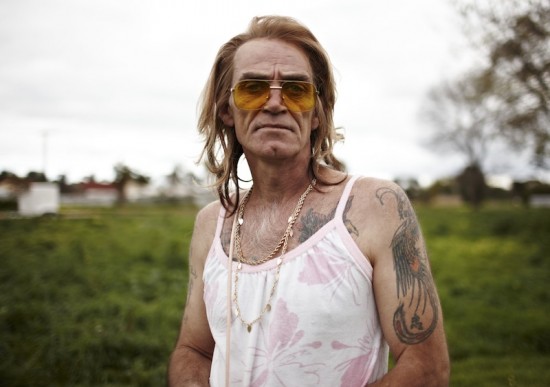![]()
 First time director Justin Kurzel’s Snowtown is the latest instalment in the burgeoning genre of what can be called, for want of a better term, ‘underclass cinema’.
First time director Justin Kurzel’s Snowtown is the latest instalment in the burgeoning genre of what can be called, for want of a better term, ‘underclass cinema’.
Animal Kingdom (2010), Samson and Delilah (2009), Boxing Day (2007), Candy (2006), The Boys (1998), and Idiot Box (1996) are all Australian examples of underclass cinema, as are US films like Winter’s Bone (2010) and Frozen River (2008), to name a few.
What they share is their almost forensic depiction of the criminal, sexual and psychological dysfunction of the underclass in Western post-industrial society. I don’t want to argue about whether these films are accurate or a stereotype. The answer is that most of the have elements of both.
Snowtown is set in the bleak housing estates of Adelaide’s northern suburbs. There’s lots of beige brick public housing, kids play with stolen supermarket trollies, and spent looking women fag on in front of poker machines.
Lest this needs further sign posting, within minutes of the film’s opening ground-down mother Elizabeth (Louise Harris) has let her boyfriend from across the road mind her three boys while she goes to Centrelink. He feeds them, then tells them to strip and photographs them. Their passive acquiesce to this abuse sets the tone for the rest of the film.
Elizabeth discovers the truth from one of her neighbours, a gay transvestite called Barry. She confronts the boyfriend, but its obvious her options are limited.
Enter John Bunting (Daniel Henshall). We first see him in Elizabeth’s kitchen, holding court in front of a group of local residents who are lamenting their powerlessness to do anything about the rampant child abuse in their community.
John is confident, charismatic, funny, and has an analysis. “If you were from the city, he wouldn’t be out on bail in a couple of days,” she tells Elizabeth in reference to the man whose abused her kids.
Most of all he’s a father figure to the three boys, particularly the oldest, Jamie (Luke Pittaway). John and the boys daub the word ‘fag’ all over the abusive ex-boyfriend’s house. Then he and Jamie douse the front of it in blood and pieces of butchered kangaroo.
Before long, the abuser has packed his bags and left. It’s a smart move, because John’s got plans for a lot of other people he believes have wronged the local community.
Snowtown is based on the real life murder of 12 people in South Australia between August 1992 and May 1999. The crimes were discovered when the remains of 8 of the victims were found in barrels of acid in a disused bank building in Snowtown, a small economically depressed area 145 kilometres north of Adelaide.
Four people were eventually arrested for the murders. The ringleader, Bunting, was a suburban psychopath with neo-Nazi leanings (although this is left out of the film) who hated gays, pedophiles, very fat people and drug users.
The victims were killed, often tortured beforehand, on a whim for perceived infringements of Bunting’s personal code. They included friends and relatives of the killers. The victim’s social security and bank details were obtained and the murderers continued to collect their benefits after their deaths.
It’s a pretty gutsy decision for any director to make a film about Australia’s worst serial killing spree, especially a first time director. Though I’d been looking forward to seeing Snowtown for months, while it works on some levels, overall I was disappointed.
Bunting’s first victim is Barry. He’s last seen giving Bunting and his sallow faced assistant who’s never introduced, a list of the local pedophiles and sexual deviants. Next we hear Barry’s disembodied voice on a phone answering machine message saying he’s gone to Queensland and doesn’t know when he’ll be back.
Further killings occur in rapid succession, a junkie, the fat wife of one of Bunting’s mates, a mentally disabled boy, family members. Bunting tortures his victims then forces them to record a farewell message. He tells them what to say, then edits it to sound like the real thing. It’s one of the film’s genuinely chilling effects.
There is actually very little graphic violence in Snowtown. With one exception, the killings occur off screen. Presumably, the audience is supposed to be more horrified by the way in which those who disappear are not missed and supposedly ordinary people turn a blind eye or actively assist with the killings.
Obviously, this intended to highlight the wider economic and social disempowerment in the community.
The other connection made in the film is between marginalisation and sexual dysfunction. The main thread here is way Jamie is slowly drawn into the violence, partly in response to the self-loathing he feels after he’s raped by his half brother.
That the rape is so unconvincing, both physically and in terms of plot, is key problem given that it’s central to Jamie’s motivation for becoming a killer.
The cast of largely unknown actors, many of who were plucked off the streets of northern Adelaide, don’t help either. Henshall, one of the few cast members with any acting experience is quite good. Pittway sleepwalks through the film. The mother, Elizabeth Harvey, is similarly uninspiring.
But the biggest problem is the way in which the film gives so little context for the characters’ actions. So little is explained, that in end I was left feeling much the same as the Snowtown’s characters, unconcerned and disconnected.
Thanks to Christos and Sol for assisting with this review.























Good to read your review Andrew. Like you I found the lack of context frustrating. Have ordered Jeremy Pudney’s book to fill in the gaps.